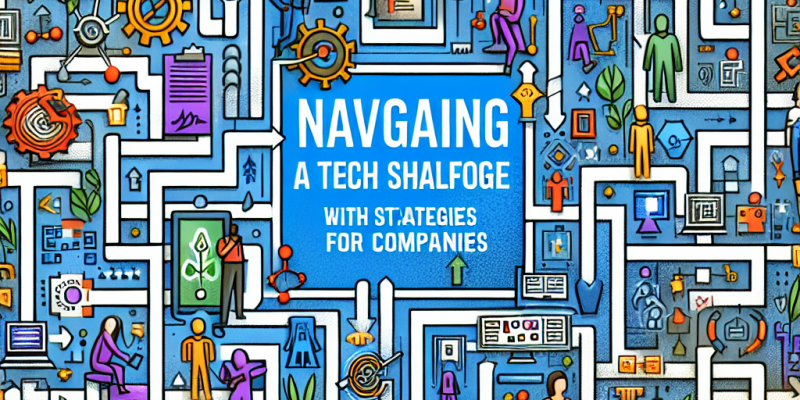Navigating the Tech Talent Shortage: Strategies and Insights for Companies

The tech industry has long been synonymous with rapid innovation, but in recent years, it has also become a battleground for talent. As companies strive to keep pace with digital transformation, the demand for skilled tech professionals has outstripped supply, leading to a pronounced tech talent shortage. This acute dilemma has the potential to hinder growth, diminish competitive advantages, and stymie innovation. However, businesses can adopt proactive strategies to navigate this challenge. Herein, we explore key insights and actionable strategies for companies aiming to secure the tech talent they need to thrive.
Understanding the Landscape
The tech talent shortage is not merely a temporary phenomenon; it reflects longstanding trends. A surge in digital transformation initiatives, coupled with the rapid proliferation of new technologies such as artificial intelligence, machine learning, and blockchain, has created a voracious appetite for skilled personnel. Moreover, the pandemic has amplified remote work flexibility, enabling companies to seek talent globally while also increasing competition among employers within local markets.
Understanding the nuances of this landscape is crucial for organizations seeking to attract and retain tech talent. This understanding should guide recruitment strategies, employee engagement practices, and professional development programs.
1. Embrace Remote Work
As remote work becomes a staple in many industries, companies should embrace this trend as an opportunity to broaden their talent pools. By adopting flexible work policies, organizations can tap into diverse markets around the globe, engaging candidates who may not be willing to relocate.
To successfully implement remote hiring, companies need to ensure robust communication tools are in place and invest in onboarding processes that foster a sense of belonging. This approach not only expands access to talent but also signals a commitment to modern workforce practices, a characteristic that is often highly valued by tech professionals.
2. Enhance Employer Branding
In a competitive job market, strong employer branding can differentiate your organization. Candidates are increasingly looking for more than just attractive salaries; they seek workplaces that align with their values. Companies should highlight their commitment to innovation, inclusivity, and work-life balance in their branding efforts.
Maintaining an active and engaging online presence, showcasing employee success stories, and being transparent about company culture can go a long way in attracting top talent. Use reviews on platforms like Glassdoor, social media, and industry forums to demonstrate your company’s positive attributes and the benefits of working there.
3. Invest in Training and Development
With many candidates lacking the specialized skills that companies require, investing in employee training can be a game changer. Initiatives such as mentorship programs, continuous learning opportunities, and partnerships with educational institutions can help bridge the skills gap.
Creating a culture of learning allows existing employees to grow into new roles, reducing the pressure to source talent exclusively from the external labor market. Furthermore, employees who feel supported in their personal and professional growth are more likely to stay long-term, thereby reducing turnover rates.
4. Foster Diversity and Inclusion
Diversity isn’t just a buzzword; it is an imperative for innovation. A diverse workforce offers different perspectives and ideas, ultimately leading to enhanced creativity and problem-solving. Companies should actively seek to create inclusive hiring practices that appeal to various backgrounds and experiences.
Take a holistic approach to diversity: evaluate your job postings to ensure they are inclusive, engage with a wider range of recruitment channels, and assess your interview processes to eliminate biases. Additionally, promoting a culture of inclusivity, where every voice is valued, can enhance employee satisfaction and retention.
5. Leverage Technology in Recruitment
Technology can significantly streamline the recruitment process, making it more efficient and effective. Implementing AI-driven tools for resume screening, predictive analytics for candidate assessment, and customized recruitment marketing can reduce time-to-hire and improve candidate experiences.
Moreover, utilizing platforms designed for tech recruiting can help companies connect with potential hires in innovative ways, such as through coding challenges or hackathons. This approach not only helps in assessing skills but also engages candidates in a meaningful way early in the hiring process.
6. Build Partnerships with Educational Institutions
Developing relationships with universities, boot camps, and other educational institutions can create a pipeline of emerging talent. By collaborating on curricula development, offering internships, and hosting workshops, companies can influence the education of future tech professionals while also gaining access to fresh talent.
Investing in these educational partnerships not only helps bridge the skills gap but also enhances your company’s reputation within the community as an industry leader committed to nurturing talent.
Conclusion
The tech talent shortage poses significant challenges for companies, but it also provides opportunities for organizations willing to adapt and innovate. By embracing remote work, enhancing employer branding, investing in training, fostering diversity, leveraging technology, and building educational partnerships, companies can effectively navigate the tech talent landscape.
In a world where the war for talent is more intense than ever, those that implement these strategies can position themselves as employers of choice, attracting and retaining the skilled professionals necessary for sustainable growth and innovation in the tech industry. Ultimately, adapting to these changes will not only address current challenges but will empower organizations to thrive in the future.














